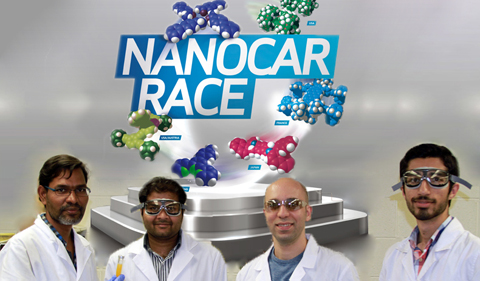
Pit crew members, from left, Karthi Perumal, Kondalarao Kotturi, Mersad Raesi and Ramin Rabbani
By Raymond Humienny
NQPI writing intern
The Ohio University BobCat Nano Wagon took home the silver medal from the first ever Nanocar Race hosted at CEMES (Centre d’Élaboration de Matériaux et d’Etudes Structurales) in Toulouse, France.
Nanoscale and Quantum Phenomena Institute members Dr. Saw-Wai Hla (Physics & Astronomy) and Dr. Eric Masson (Chemistry & Biochemistry) led their respective students in a joint effort to guide the Nano Wagon to the 100nm finish line. In Toulouse, undergraduate pit crew member Ryan Tumbleson drove the nanocar along a gold surface while the chemistry team monitored the race.
Although short of the 100nm goal, finishing second at 43nm is still a remarkable accomplishment. Relaying information in real-time between the teams is a challenge itself. Each competitor attending the meeting in France remotely controlled their vehicles’ trajectories by communicating with their pit crews at home. For the OHIO team, graduate student Kyaw Zin Latt stayed in Athens to oversee the racing conditions.
Moving the nanocar involved subliming the vehicle’s molecules onto the gold track and probing it with an electron from a STM (scanning tunneling microscope) tip. The pit crew had to be careful not to upset the Nano Wagon’s molecular configuration; probing nanocars with STMs gradually heats the gold surface. At higher gold surface temperatures, the Nano Wagon risked destruction while at lower ones, propulsion was unlikely.
The OHIO team secured a victory in constructing the largest supramolecular nanovehicle for the event. Constructed with 644 atoms, the Nano Wagon was awarded “The Texan” for its sheer size. Graduate student pit crew member Kondalarao Kotturi said that synthesis of this “monster truck” has opened avenues for his nano-car research proposal.
“We have to build different versions of the car … to understand whether the wheels are rolling or sliding by designing other models,” Kotturi said.
According to his recent findings, Masson said that the wagon wheels are likely to be rolling.
“The primary data and our personal experience with that molecule (is) there is almost no friction,” Masson said. “When the axel is inside the wheel, the wheel can rotate with virtually no friction.”
While the BobCat Nano Wagon might have seen its last race, the same cannot be said for future models. Another Nanocar Race is currently in the works at CEMES.
“We don’t know what the rules are going to be,” Masson said. “I’m sure there’s going to be another exciting challenge, but there will be a race.”



















Comments